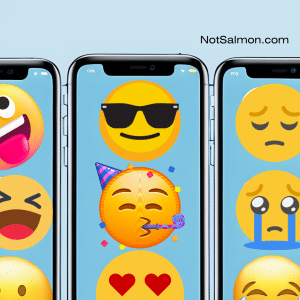
Get A Sneak Peek at my book “Your To-Die-For Life”!
Get a FREE sneak peek! Learn how to use Mortality Awareness as a wake up call to live more boldly.
 Coming up, I’m going to explain something called “Emojional Intelligence” – and you’ll learn how to become more “Emojionally Intelligent” with some interesting studies and tips.
Coming up, I’m going to explain something called “Emojional Intelligence” – and you’ll learn how to become more “Emojionally Intelligent” with some interesting studies and tips.
Ever caught yourself using a thumbs-up 👍 or a facepalm 🤦 in an email or text chat? Well, you’re speaking in the language of emojis, adding color and pizzazz to your digital conversations.
From classic smiles 🙂 to snazzy dancers 💃, these tiny symbols are constantly popping up in our digital chats!
But they’re more than just mere fun doodles. They’re also a useful way to better express our feelings.
And they can even reveal things about our age, our gender preference, our culture, etc…
Think of Emojional Intelligence as the art of using emojis to communicate and understand one’s deepest emotions, thoughts, and nuances. In many ways, emojis are like an actual language. And I’m here to help you to be more fluent in the language of emojis.
Long before emojis, humans were already communicating through hieroglyphics and pictorial scripts. Emojis are, in many ways, a modern evolution of these ancient images.
In the late 1990s, Shigetaka Kurita, a Japanese engineer, laid the foundation for emojis. His set of 176 emojis were pixelated – but revolutionary. His designs were created to try to bring some emotional nuance to digital communication. And they sure as heck worked! 🎉
Today, as ExpressVPN revealed, there are over 3,600 emojis gracing our devices and platforms, which is a testament to their widespread integration. Just as original emojis injected feeling into digital chats, modern emojis continue to enhance our expression of sentiments across the virtual realm.
But why did emojis catch on so fast? Think back to the iconic smiley face of the 70s. 🙂 Visual cues always transcend language barriers. Emojis further that cause, allowing for universally understandable expressions in a fast-paced world.
When you send a heart emoji ❤️, are you merely sending a graphic? Or is there a heartbeat behind it? Flinders University, led by Owen Churches, discovered our brains react to emojis similarly to human faces.
This could be the underlying reason why “Let’s meet up later 🍕” resonates differently than just words.
And it’s also why a thumbs-up 👍 in a text isn’t just a symbol. It communicates and resonates approval, much like a nod in face-to-face conversations.
Remember the strong positive response when Apple introduced diverse skin tones for hand emojis? It was a testament to the fact that people saw emojis as extensions of their identity, not just mere symbols.
At this point in our world, it’s important to become Emojionally Intelligent. After all, emojis have become an important factor in helping people be more emotionally expressive in texts, emails, and social media – particularly on platforms with character limits.
An interesting study in the journal Trends in Cognitive Sciences suggested that frequent emoji users understand and interpret emojis as emotional experiences. If someone texts “Feeling so 🥺“, it might be easier for us to empathize with their vulnerability than if they had used words alone.
Further, the University of Michigan found that couples who use more positive emojis have more intimate and fulfilling relationships. So, a barrage of ❤️💏💌 actually helps to boost emotional connection!
A study in the journal Trends in Cognitive Sciences explained that emojis kind of work like”digital surrogates” for our human tone of voice, facial expressions, and gestures.
Basically… while words in print can be powerful, they can sometimes fall flat. And so, emojis can help enhance, refine, and sometimes even redefine our messages.
Emojis: Windows to Our Identity
Our emoji choices often mirror our identities:
Corporate emails were once rigid. But now, many have noticed a sprinkle of emojis – and they’re being used on purpose – strategically.
The University of Missouri-St. Louis discovered emojis in the workplace are actually helping to create a more positive company culture.
For example…
As cultures and societies evolve, so do emojis. They now proudly showcase diversity with icons like 🧕 (woman with headscarf), 🏳️🌈 (rainbow flag symbolizing LGBTQ+ pride), and 🤝 (handshake signifying unity and agreement). Emojis are breaking barriers and championing inclusivity, making everyone feel seen and represented.
The story of emoji diversity has its roots in actual real-world movements for equality and representation.
When the Black Lives Matter movement was gaining momentum worldwide, the push for more diverse skin tones in emojis became stronger than ever. The Unicode Consortium, responsible for emoji standards, listened. In 2015, they introduced a set of skin tone modifiers, allowing users to choose from a more diverse palette of human emojis. This was a pivotal moment, not just for the emoji world but as a reflection of broader societal change.
While emojis initially leaned into traditional gender roles, with male emojis depicted in jobs and female emojis often limited to beauty or relational roles, this began to change with active advocacy. The introduction of emojis like the female construction worker 👷♀️ and the male figure getting a haircut 💇♂️ helped challenge and dismantle these stereotypes.
Beyond gender and skin color, emojis started paying attention to cultural nuances.
Educators are starting to tap into the emoji trend, too. Emojis are being used to make lessons more fun.
People love emojis, and they keep getting better and more diverse. Have you ever thought about what could come next? Some tech experts believe we might be able to use advanced technology to make emojis even cooler in the future.
There’s talk about mixing emojis with Augmented Reality (AR). Just imagine if instead of sending a simple 😲 – you could send a 3D version that pops out of the screen – with a 3D version of your own face, mouth agape, eyes wide, thanks to AR.
While this idea is exciting, it is more than a distant dream. In fact, Samsung has already made strides in this direction with their Augmented Reality Emoji feature, allowing users to infuse their communications with animated 3D emojis that mirror their facial expressions and reactions.
We know that the Unicode Consortium keeps adding more each year. They’re always thinking about how to make emojis fit our ever-changing world.
Emojis are like the fun stickers of our chats! 🎉 From ancient drawings on cave walls to now slapping a 😂 in a text, we’ve always loved using pictures to chat. With so many emojis out there, our messages are livelier than ever.
And who knows? Maybe in the future, we’ll have an emoji perfect for that weird feeling when you can’t find your phone in your pocket. Until then, keep on emoji-ing and maybe throw in a 🕺 or 💃 now and then. After all, why just say it with words when you can jazz it up with an emoji? 😉🎈
If you want to live your best life… I’m the founder of the therapist recommended program The Tweak a Week Online Course – which helps people to make small, positive changes in their habits that lead to big results.
P.S. Before you zip off to your next Internet pit stop, check out these 2 game changers below - that could dramatically upscale your life.
1. Check Out My Book On Enjoying A Well-Lived Life: It’s called "Your To Die For Life: How to Maximize Joy and Minimize Regret Before Your Time Runs Out." Think of it as your life’s manual to cranking up the volume on joy, meaning, and connection. Learn more here.
2. Life Review Therapy - What if you could get a clear picture of where you are versus where you want to be, and find out exactly why you’re not there yet? That’s what Life Review Therapy is all about.. If you’re serious about transforming your life, let’s talk. Learn more HERE.
Think about subscribing for free weekly tools here.
No SPAM, ever! Read the Privacy Policy for more information.